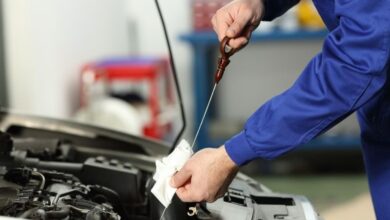A Comprehensive Guide to Checking and Changing the Coolant in Your Vehicle

Maintaining the optimal operating temperature of your vehicle’s engine is paramount for its performance and longevity, and a key player in achieving this is the coolant. “A Comprehensive Guide to Checking and Changing the Coolant in Your Vehicle” is your go-to resource for understanding the importance of coolant, learning how to inspect its condition, and mastering the art of a coolant change.
This comprehensive guide is crafted to empower you with the knowledge and skills needed to keep your engine cool and running smoothly. From the significance of the coolant to the step-by-step process of checking its condition and performing a coolant change, we’ll cover every aspect of this crucial aspect of vehicle maintenance.
Join us on a journey through the intricacies of vehicle cooling systems, exploring the types of coolants available, deciphering warning signs of coolant issues, and understanding the importance of regular maintenance. Whether you’re a seasoned DIY enthusiast or a car owner looking to enhance your understanding of essential vehicle care, this guide aims to be your comprehensive companion to the world of checking and changing the coolant in your vehicle. Let’s delve into the realm of engine health and ensure your vehicle runs smoothly for miles to come.

Contents
- 1 Understanding the Importance of Coolant
- 2 Gathering the Necessary Tools and Materials
- 3 Identifying the Coolant Reservoir
- 4 Checking the Coolant Level
- 5 Testing the Coolant Strength
- 6 Draining and Changing the Coolant
- 7 Final Checks and Maintenance Tips
- 8 Coolant Care 101: A Comprehensive Guide to Checking and Changing the Coolant in Your Vehicle
Understanding the Importance of Coolant
Before we delve into the process of checking and changing the coolant, let’s first understand why coolant is vital for your vehicle’s engine. Coolant, also known as antifreeze, plays a crucial role in regulating the temperature of the engine. It prevents overheating by absorbing excess heat from the engine and dissipating it through the radiator. Additionally, coolant also provides protection against freezing during colder temperatures, preventing any potential damage to the engine block and other vital components.
Gathering the Necessary Tools and Materials
To effectively check and change the coolant in your vehicle, you will need a few tools and materials. Here’s a list of what you’ll need:
- Safety goggles
- Gloves
- Coolant tester or hydrometer
- Funnel
- Distilled water (if required)
- New coolant/antifreeze (as per your vehicle’s specifications)
- Drain pan or container
See more: Evaluating the Vehicle’s Autonomous Driving Capabilities: A Comprehensive Guide
Identifying the Coolant Reservoir
The first step is to locate the coolant reservoir in your vehicle. The coolant reservoir is usually a translucent plastic container with high and low-level markings. It is often located near the radiator or the engine compartment. Refer to your vehicle’s owner’s manual if you have trouble finding it.
Checking the Coolant Level
Now that you have located the coolant reservoir, it’s time to check the coolant level. Follow these steps:
- Ensure that your vehicle’s engine is cool before proceeding.
- Put on safety goggles and gloves to protect yourself from any potential splashes.
- Open the hood of your vehicle and locate the coolant reservoir.
- The reservoir will have two markings – high and low. The coolant level should ideally be between these two markings.
- If the level is below the minimum (low) marking, it indicates that your vehicle is running low on coolant and needs to be topped up.
- If the level is consistently low, it may indicate a leak in the cooling system, which should be addressed by a professional mechanic.
Testing the Coolant Strength
Apart from checking the coolant level, it is also crucial to test its strength periodically. The strength of the coolant is measured by its freezing and boiling points, which are essential for protecting your engine in extreme weather conditions. To test the coolant strength, follow these steps:
- Use a coolant tester or hydrometer to check the specific gravity or freeze point of your coolant.
- Insert the tester into the coolant reservoir and draw some coolant into it.
- Check the reading on the tester to determine its freeze point.
- Compare the reading with the recommended freeze point mentioned in your vehicle’s owner’s manual.
- If the reading is below the recommended level, it is advisable to change the coolant to ensure optimal protection.
The Importance of Regular Maintenance for Your Vehicle’s Air Conditioning System
Draining and Changing the Coolant
If you’ve determined that your coolant needs to be changed, follow these steps to drain and replace it:
- Ensure that your vehicle’s engine is cool before proceeding.
- Place a drain pan or container underneath the radiator drain plug to collect the old coolant.
- Locate the radiator drain plug (usually at the bottom of the radiator) and open it using a wrench.
- Allow the old coolant to completely drain into the pan/container.
- Once all the coolant has been drained, close the drain plug securely.
- Refer to your vehicle’s owner’s manual to identify whether there are any additional drain plugs in other parts of the cooling system (e.g., engine block) that need to be opened for complete drainage.
- Once drained, dispose of the old coolant responsibly according to local regulations.
- Use a mixture of new coolant and distilled water (if required) as per your vehicle manufacturer’s recommendations to refill the cooling system.
- Slowly pour the new coolant mixture into the radiator using a funnel to avoid any spills or air bubbles.
- Continue pouring until the coolant reaches the appropriate level in the coolant reservoir.
- Securely replace the radiator cap.
Final Checks and Maintenance Tips
After changing the coolant, it is important to conduct some final checks and follow some maintenance tips:
- Start your vehicle and allow it to run for a few minutes while monitoring the temperature gauge.
- Ensure that there are no leaks in the cooling system by inspecting all connections and hoses for any signs of leakage.
- Verify that there are no air bubbles trapped in the system by gently squeezing any accessible hoses while the engine is running.
- Double-check that the coolant level is within the recommended range on the coolant reservoir.
- Regularly monitor your vehicle’s temperature gauge during subsequent drives to ensure that it remains within the normal operating range.
Coolant Care 101: A Comprehensive Guide to Checking and Changing the Coolant in Your Vehicle
Regularly checking and changing the coolant in your vehicle is crucial for maintaining its performance and preventing potential engine damage due to overheating or freezing conditions. By following this comprehensive guide, you can confidently perform this essential maintenance task yourself, ensuring a well-functioning cooling system and extending the lifespan of your vehicle’s engine. Remember, if you encounter any difficulties or are unsure about any step, consult a professional mechanic for assistance.
So there you have it – a complete guide on checking and changing the original water (coolant) in your vehicle! Keep your engine cool and protected by staying on top of this important maintenance task.
See more at: Car Care Vip





































